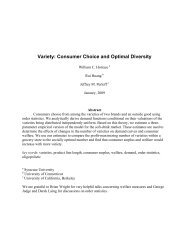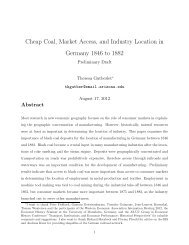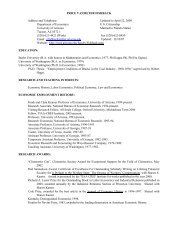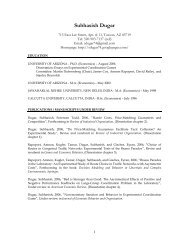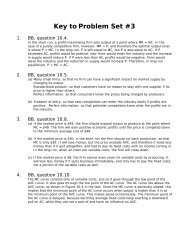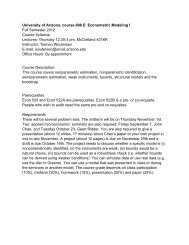A Dynamic Model of Demand for Houses and Neighborhoods
A Dynamic Model of Demand for Houses and Neighborhoods
A Dynamic Model of Demand for Houses and Neighborhoods
You also want an ePaper? Increase the reach of your titles
YUMPU automatically turns print PDFs into web optimized ePapers that Google loves.
(BLP) style models to allow <strong>for</strong> <strong>for</strong>ward looking behavior, while retaining controls <strong>for</strong> unob-<br />
served product characteristics <strong>and</strong> allowing <strong>for</strong> consumer preference heterogeneity. Melnikov<br />
(2001) develops a tractable model without individual heterogeneity <strong>and</strong> uses it to estimate the<br />
dem<strong>and</strong> <strong>for</strong> printers. Carranza (2007) extends the Melnikov (2001) model to allow <strong>for</strong> r<strong>and</strong>om<br />
coefficients <strong>and</strong> captures the dynamic decision using a reduced <strong>for</strong>m specification. By allowing<br />
consumers to make repeat purchases, Gowrisankaran <strong>and</strong> Rysman (2007) allow both the timing<br />
<strong>and</strong> product choices to be determined dynamically. They estimate their model by nesting a Rust<br />
(1987) style optimal stopping problem inside <strong>of</strong> the BLP style product choice model. Schiraldi<br />
(2007) extends the Gowrisankaran <strong>and</strong> Rysman (2007) model to include secondary markets <strong>and</strong><br />
transaction costs. Erdem, Imai, <strong>and</strong> Keane (2003) estimate a structural model that controls<br />
<strong>for</strong> the effects <strong>of</strong> inventory build up <strong>and</strong> expectations about future price changes. Their model,<br />
while computationally dem<strong>and</strong>ing, allows <strong>for</strong> individual heterogeneity. Using the market <strong>for</strong><br />
laundry detergent, Hendel <strong>and</strong> Nevo (2006) estimate a similar model. They structure their<br />
model such that they can separate a static br<strong>and</strong> choice <strong>and</strong> dynamic quantity choice, leading to<br />
computational simplifications. Their model, however, cannot allow <strong>for</strong> individual heterogeneity.<br />
A common issue in dynamic discrete choice models is the direct link between the size <strong>of</strong> the<br />
choice set <strong>and</strong> the size <strong>of</strong> the state space. St<strong>and</strong>ard estimation approaches such as Rust (1987)<br />
quickly become infeasible with a large choice set. Melnikov (2001) <strong>and</strong> Hendel <strong>and</strong> Nevo (2006)<br />
propose a potential solution to this problem where the current logit inclusive value is treated as<br />
a sufficient statistic <strong>for</strong> predicting future continuation values. Tractability is maintained as the<br />
state space is reduced to one dimension by this assumption, but this simplification comes at a<br />
cost <strong>of</strong> a loss <strong>of</strong> in<strong>for</strong>mation. 3<br />
Our model, which is based on individual data, incorporates unobserved choice characteris-<br />
tics, endogenous wealth accumulation, <strong>and</strong> heterogeneous households. Using individual data,<br />
we capture heterogeneity by allowing individuals to value neighborhood attributes differently<br />
based on their observable characteristics. 4 Our approach differs from previous models as it<br />
does not require the reduction <strong>of</strong> the state space to a univariate statistic. Rather, we can avoid<br />
3 Similar assumptions are made in Carranza (2007), Gowrisankaran <strong>and</strong> Rysman (2007), <strong>and</strong> Schiraldi (2007).<br />
4 In addition to specifying a dynamic model, we also differ from BLP by allowing heterogeneity in the valuation<br />
<strong>of</strong> unobserved neighborhood characteristics – we allow individuals to value unobserved neighborhood attributes<br />
differently based on their observable characteristics.<br />
4



